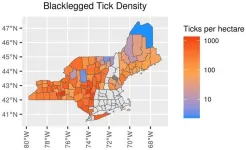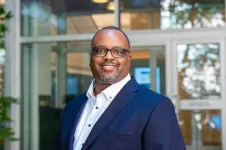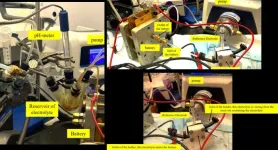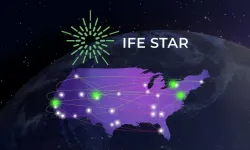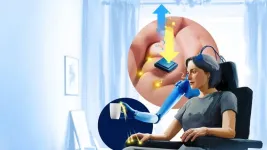(Press-News.org) A group of immune proteins called the inflammasome can help prevent blood stem cells from becoming malignant by removing certain receptors from their surfaces and blocking cancer gene activity, according to a preclinical study by Weill Cornell Medicine investigators.
The study, published Jan. 2 in Nature Immunology, may lead to therapies that target the earliest stages of cancer. The findings bolster the idea that the inflammasome has a dual role—it promotes inflammation associated with poor outcomes in late cancer stages, but early on, it can help prevent cells from becoming cancerous in the first place.
“What was striking was that the innate immune system, which includes the inflammasome, has a role beyond infection,” said Dr. Julie Magarian Blander, the Gladys and Roland Harriman Professor of Immunology in Medicine and a member of the Jill Roberts Institute for Research in Inflammatory Bowel Disease at Weill Cornell Medicine. “We found that it functions in maintaining homeostasis in the tissue, keeping an eye on whether stem cells are proliferating too much. By doing so, it prevents cells from becoming cancerous and this activity is independent of inflammation.”
The co-first authors of the study are Dr. Andrew Kent, an assistant professor of medicine-hematology at the University of Colorado School of Medicine and Dr. Kristel Joy Yee Mon, a postdoctoral associate in Dr. Blander’s lab.
Origin Story
By the time patients typically go to the doctor with cancer symptoms, tumors have already formed. As a result, very little is known about cancer’s beginnings.
To get a better understanding of how the disease takes hold, Dr. Blander and her colleagues chose to study a mouse model of B-cell lymphoma called Eµ-myc, which has a mutation in the Myc oncogene. These mice have a long delay before tumors develop, giving researchers a chance to observe what happens early on in cancer. Because B-cell lymphoma develops in a type of white blood cell, the team examined their precursors, called hematopoietic stem cells, in the mice.
Genetically disrupting inflammasome activity in the Eµ-myc mice greatly accelerated stem cell proliferation and tumor development. The investigators were surprised to find that stem cells in control mice that lacked the inflammasome also proliferated at a fast pace compared with wild-type mice, suggesting that the complex has an important role in healthy cells, too. The team found that without the inflammasome, the stem cells have high levels of the protein Ras, which is another oncogene product. This protein can work together with mutant Myc to drive cancer, so the inflammasome’s normal job of keeping Ras in check delays tumorigenesis.
Ground zero for the protective activity was not the hematopoietic stem cells themselves, but the bone marrow stroma, a collection of many cell types surrounding and nurturing the stem cells.
Higher levels of soluble tumor necrosis factor (TNF) receptors were found in the stroma of control mice compared with the inflammasome-deficient mice. “It turned out that TNF receptors were being shed from stem cells in control mice, and they were being retained on stem cells from inflammasome-deficient mice. Higher TNF receptor levels lead to increased stem cell proliferation. Maintaining a healthy level of TNF receptors becomes important for these stem cells to maintain homeostatic control of proliferation,” said Dr. Blander. “We think that the inflammasome in the stroma is orchestrating something where it’s cleaving TNF receptors, shaving them off the stem cells.”
Next steps
Next, the team will test for the inflammasome’s protective effects in other tissues. In addition, they will determine which of the stromal cell types is responsible for the activity, and which molecules the inflammasome is using to suppress cell growth.
Ultimately, the researchers hope that the study will lay the groundwork for a therapeutic that would stave off cancer. “A therapy could target the inflammasome, but it should be directed only to the inflammation side of its activity that is associated with tumor progression,” said Dr. Blander, who is also a member of the Sandra and Edward Meyer Cancer Center at Weill Cornell Medicine. “You want to protect the inflammasome’s beneficial function of delaying tumorigenesis.”
Many Weill Cornell Medicine physicians and scientists maintain relationships and collaborate with external organizations to foster scientific innovation and provide expert guidance. The institution makes these disclosures public to ensure transparency. For this information, please see the profile for Dr. Julie Magarian Blander.
The work reported in this story was supported in part by the National Institute of Allergy and Infectious Diseases, part of the National Institutes of Health, through grant numbers AI170832, AI170897, AI159772, and AI178327. Additional support was provided by the Jill Roberts Institute for Research in IBD at Weill Cornell Medicine.
END
Immune complex shaves stem cells to protect against cancer
2025-01-16
ELSE PRESS RELEASES FROM THIS DATE:
In the Northeast, 50% of adult ticks carry Lyme disease carrying bacteria
2025-01-16
Across most of the Northeast, getting bitten by a blacklegged tick— also called a deer tick — is a risk during spring, summer, and fall. A new Dartmouth study, published in Parasites and Vectors, finds that 50% of adult blacklegged ticks carry the bacteria that causes Lyme disease while 20% to 25% of the younger (nymph) blacklegged ticks carry the bacteria.
A team of researchers from universities, health departments, and agricultural agencies from across the Northeast conducted a meta-analysis of data on how many blacklegged ticks there are and how many of them have the potential to pass pathogens ...
U of A Cancer Center clinical trial advances research in treatment of biliary tract cancers
2025-01-16
TUCSON, Arizona — The results of a clinical trial led by researchers at the University of Arizona Health Sciences and published in the Journal of Clinical Oncology showed that chemotherapy combining three different types of drugs did not improve overall survival for patients with advanced stage, inoperable biliary tract cancers.
“Biliary tract cancer is comparatively rare, but it’s aggressive and spreads fast. Our accrual of more than 450 patients in a little more than two years really shows there is a need for new ways to help people with biliary tract cancer,” ...
Highlighting the dangers of restricting discussions of structural racism
2025-01-16
PHILADELPHIA (January 16, 2025) – A new Health Affairs Health Policy Brief highlights the detrimental impact of recent state and federal policies that restrict discussions of “divisive concepts,” including structural racism. It warns that these policies undermine efforts to address health inequities and improve population health.
“By limiting discussions of structural racism, these policies ignore the historical and environmental factors that shape health outcomes,” said co-author Derek Griffith, PhD, the Risa Lavizzo-Mourey ...
NYU Tandon School of Engineering receives nearly $10 million from National Telecommunications and Information Administration
2025-01-16
NYU Tandon, collaborating institutions and industry partners have been awarded nearly $10 million to develop next generation communications technology.
The project, dubbed SALSA (Spectrally Agile Large-Scale Arrays), is funded by the U.S. Department of Commerce's National Telecommunications and Information Administration (NTIA) to advance U.S. leadership in open, secure communications infrastructure.
SALSA aims to create advanced wireless systems that operate in the "upper mid-band" spectrum — a region of frequencies relatively ...
NASA scientists find new human-caused shifts in global water cycle
2025-01-16
In a recently published paper, NASA scientists use nearly 20 years of observations to show that the global water cycle is shifting in unprecedented ways. The majority of those shifts are driven by activities such as agriculture and could have impacts on ecosystems and water management, especially in certain regions.
“We established with data assimilation that human intervention in the global water cycle is more significant than we thought,” said Sujay Kumar, a research scientist at NASA’s Goddard Space Flight Center in Greenbelt, Maryland, and a co-author ...
This tiny galaxy is answering some big questions
2025-01-16
Leo P, a small galaxy and a distant neighbor of the Milky Way, is lighting the way for astronomers to better understand star formation and how a galaxy grows.
In a study published in the Astrophysical Journal, a team of researchers led by Kristen McQuinn, a scientist at the Space Telescope Science Institute and an associate professor in the Department of Physics and Astronomy at the Rutgers University-New Brunswick School of Arts and Sciences, has reported finding that Leo P “reignited,” reactivating during a significant period on the timeline of the universe, producing stars when many other small galaxies didn’t.
By ...
Large and small galaxies may grow in ways more similar than expected
2025-01-16
A team of astronomers led by University of Arizona researcher Catherine Fielder has obtained the most detailed images of a small galaxy and its surroundings, revealing features typically associated with much larger galaxies. The observations provide a rare, elusive glimpse into how small galaxies form and evolve, suggesting that the mechanisms fueling galaxy growth may be more universal than previously thought.
Fielder presented the findings at the 245th meeting of the American Astronomical Society in National Harbor, Maryland, during a press briefing ...
The ins and outs of quinone carbon capture
2025-01-16
Carbon capture, or the isolation and removal of carbon dioxide from the atmosphere during industrial processes like cement mixing or steel production, is widely regarded as a key component of fighting climate change. Existing carbon capture technologies, such as amine scrubbing, are hard to deploy because they require significant energy to operate and involve corrosive compounds.
As a promising alternative, researchers from the Harvard John A. Paulson School of Engineering and Applied Sciences (SEAS) have developed carbon capture systems that use molecules called ...
Laboratory for Laser Energetics at the University of Rochester launches IFE-STAR ecosystem and workforce development initiatives
2025-01-16
The University of Rochester’s Laboratory for Laser Energetics (LLE) has been awarded a $2.25 million grant over three years from the US Department of Energy’s Office of Fusion Energy Sciences. This funding establishes the Inertial Fusion Energy Science and Technology Accelerated Research (IFE-STAR) ecosystem that brings together academia, national laboratories, and the private sector to develop a clean, safe, and virtually limitless energy source, built on US leadership in inertial fusion.
Inertial ...
Most advanced artificial touch for brain-controlled bionic hand
2025-01-16
For the first time ever, a complex sense of touch for individuals living with spinal cord injuries is a step closer to reality. A new study published in Science, paves the way for complex touch sensation through brain stimulation, whilst using an extracorporeal bionic limb, that is attached to a chair or wheelchair.
The researchers, who are all part of the US-based Cortical Bionics Research Group, have discovered a unique method for encoding natural touch sensations of the hand via specific microstimulation patterns in implantable electrodes in the brain. This allows individuals with spinal cord injuries ...
